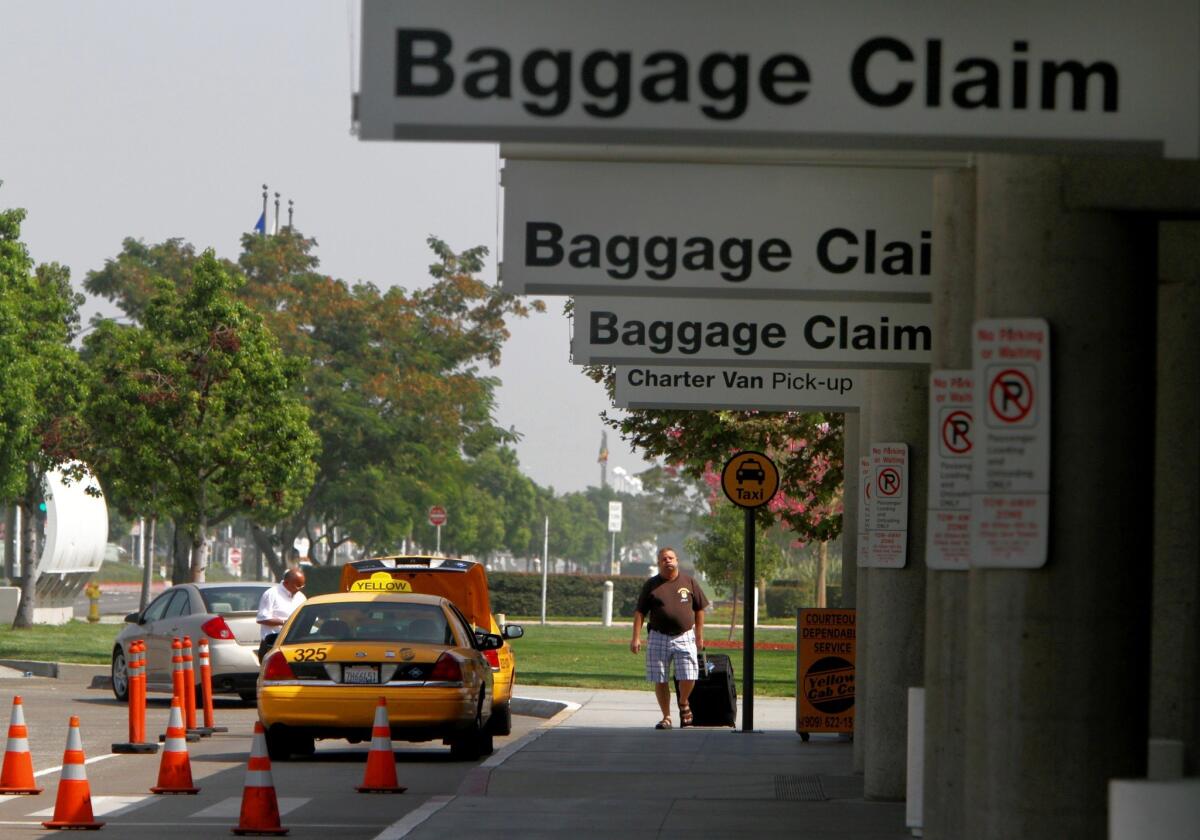Ontario airport is less crowded than LAX, but there’s a price to pay

- Share via
Question: Using L.A./Ontario International Airport for flights is much more convenient for me than LAX. I can’t understand why the cost of flights is so much higher at Ontario compared with LAX. I cannot stand the long drive to LAX and the crazy traffic in the airport. Ontario airport is a great place with convenient parking and nice terminals. What gives?
Russell Yamanaka
Rowland Heights
Answer: Economics. Forever. And always. And maybe some other stuff, depending on whom you believe.
If you look at the weekly airfare chart on Page L6 of the print section, you can see some of the differences in domestic fares.
Perhaps the most unsettling is LAX-Las Vegas and Ontario-Las Vegas.
Fly out of behemoth LAX — on pace to serve more than 71 million passengers this year — and your cost will start at $124 on American, Delta, Southwest, United, US Airways or Virgin America. Fly out of Ontario, which will be lucky to serve 4 million this year, and your tab starts at $242 on United or US Airways.
If you have a sense of irony, you’ll note that your drive to the Strip from Ontario can take almost an hour off the trip (it’s about 50 miles closer) than if you were to motor from LAX.
You’ll find a price variance — sometimes enormous — on every route listed in the chart. While you’re wincing at the premium you’ll pay for service out of Ontario, notice how many more carriers fly out of LAX.
Part of the answer to higher prices? The number of competitors.
The LAX-Atlanta route, for instance, shows seven carriers serving Atlanta; from Ontario, three.
What’s worrisome for consumers, no matter where they fly from, is what’s happened/is happening with the airline industry, as suggested by airlines listed on the LAX-Atlanta run: American, Delta, Frontier, United, US Airways, Southwest and AirTran.
On Dec. 28, AirTran flies its last flight, completing its merger with Southwest. American and US Airways are still becoming one but should have one website by the end of next year. Delta merged with Northwest in 2008. United merged with Continental in 2010.
That leaves Denver-based Frontier, which announced last month that it was transitioning to an “ultra-low-cost carrier” and would be cutting flights on less-profitable routes.
“Competition is not only the basis of protection to the consumer, but is the incentive to progress.” That gem is from President Herbert Hoover, who is generally blamed for the Great Depression by those seeking a scapegoat. His thought pretty much sums up why there’s increasing pain in your wallet and dismay in your heart about progress (in the form of lower prices) versus airline profits.
You may feel some flicker of hope about prices, thanks to lower fuel costs, but let me extinguish that for you, at least, for now.
George Hoffer, professor of economics at University of Richmond in Virginia, noted that airlines buy fuel hedges — that is, fuel bought at a certain price per gallon so that carriers consistently pay the same amount per gallon. If fuel prices go up, they are paying less than market price. If prices drop, they pay more. It may be some time before airlines can take advantage of lower prices, Hoffer said.
What might provide some hope, Hoffer said: Lower prices mean a friendlier environment for airline start-ups. We’ve seen that with Norwegian Air Shuttle, which is providing some moderating influence on European airfares.
For now, though, the lack of competition isn’t helping Ontario.
Add to this the economics of San Bernardino and Riverside counties, two of the main areas it serves, both of which got walloped by a souring economy. In 2009, San Bernardino’s unemployment hit 12.9% and Riverside’s 13.4%. (Los Angeles County’s was 11.6%.) Those figures are much improved — in October, San Bernardino was 7.7%, Riverside 8.4% — but it’s an arduous climb out of a deep hole.
Noting that the Inland Empire was hit disproportionately hard by that crisis, a Los Angeles World Airports report called “Q&A: L.A./Ontario International Airport: Common Questions and Answers About the Airport” notes that “the economic rebound in the IE will play a strong role in the recovery of ONT’s air travel.”
It’s hard to dispute that, but everything becomes suspect when a lawsuit is involved, and there is one: The city of Ontario would like control of the airport and blames Los Angeles World Airports for the decline in passenger numbers and says neglect of its airport caused the drop. The airport says otherwise.
The question remains this: Whither Ontario? Or wither Ontario?
It’s unclear for now, but what you can expect, in all probability, is that you’ll pay a premium for convenience. Like that $4.99 half-gallon of milk you buy at the Quikkie Stop rather than paying $2.99 at your local grocer, airfares at Ontario will continue to put a bigger hole in your travel wallet in exchange for LAX avoidance. Alas, you’re stuck with this dilemma: conserving your wealth or saving your mental health.
Have a travel dilemma? Write to [email protected]. We regret we cannot answer every inquiry.
More to Read
Sign up for The Wild
We’ll help you find the best places to hike, bike and run, as well as the perfect silent spots for meditation and yoga.
You may occasionally receive promotional content from the Los Angeles Times.







